Scotland's Gardens Scheme through the decades. An archive diary, by Volunteer Archivist, Alice Manning.
Hi there,
I’m Alice, a postgraduate student with the University of Dundee’s Archives and Records Management programme, and I’ve been cataloguing Scotland’s Garden Scheme’s archival records. I’ve previously worked in other archives in Edinburgh and have been really enjoying delving into SGS’s archive, hoping to make the records more accessible to staff and researchers, whilst improving their current packaging.
There is a great range of records in the archive; from the guidebook going all the way back to 1931 (if you have a copy of the guidebook from 1933, 1934, or 1952 please get in touch) to royal records. Different SGS publications are also included - I loved the recipe book with contributions from well-known individuals and organisations. Tony Blair, M.P at the time, contributed a carrot and sweet potato soup recipe.
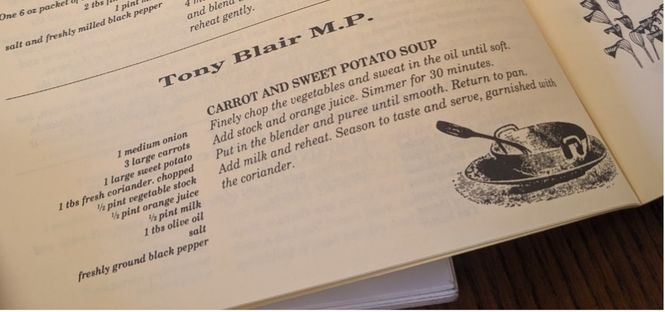
There are always snippets of gardening advice you can gain from the records, and the archive really reflects the different times SGS was operating in – with war time gardens used for bomb shelters and food production more than anything else. In particular the establishment of the NHS and the changing nature of the beneficiaries of money raised is documented. For SGS the records are integral for showing the establishment and development of the organisation –with earlier records pre-NHS showing the need for charitable fundraising for the Queen’s Nurses (their wages and pensions), and post-NHS changes such as the internet being discussed in meeting minutes (the consensus was that the internet might be quite popular, a good call I’d say).
The long term plan for the archive is for it to be deposited with an established archive service so it can be looked after, and continue to be accessible to SGS staff and outside researchers. There is so much social history in the records that they really are a treasure trove. AGM minutes record governance decisions taken over the years by SGS, but they always seem to include something a bit different too. For example, the minutes of the forty-fifth joint meeting of the gardens committee, county and district organisers, secretaries, treasurers and garden owners in 1967 included the poem quoted by the chairperson in the meeting…
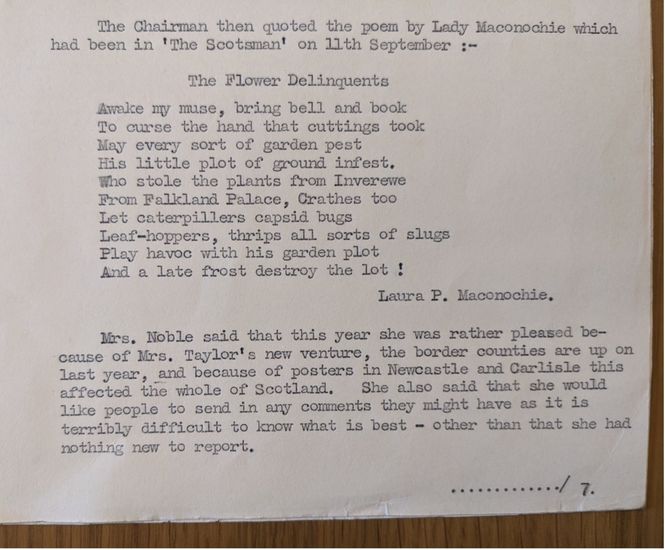
Cataloguing has meant understanding the organisation and using the impressive knowledge of staff members, they have filled in the background which explains the records themselves. This has informed my understanding of how the records relate to one another, and assisted with the catalogue arrangement. This is important so that researchers and future staff will be able to understand the context of the records. I feel like I’ve also had the chance to get to know previous staff members through the archive – you get used to recognising that a document is from a certain era of SGS as you recognise the hallmarks of the staff. I’m sure future archivists and researchers in the next millennium will rely on the current team’s records similarly!
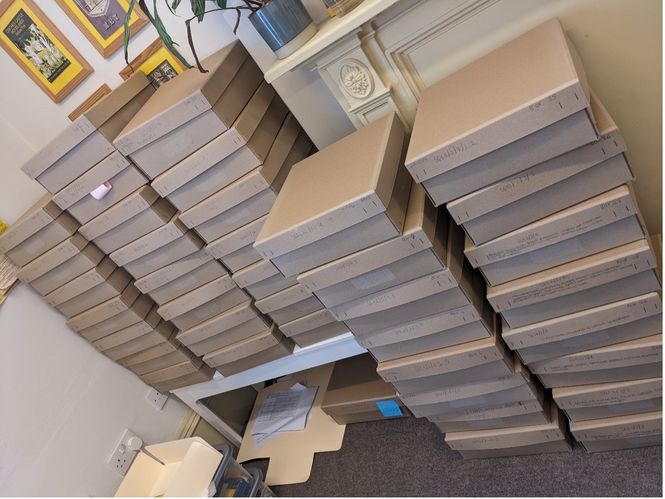
It has been very satisfying filling up boxes and ensuring the catalogue references and locations are all filled in. When staff members have asked if I can point them to a specific record they need it has been very reassuring searching the catalogue and producing the record – shows how important cataloguing is for the accessibility of the collection, even within the office! Records have been repackaged following conservation guidelines – they’re all stored flat in acid-free packaging in archive boxes. This will help ensure their longevity.
Indeed, the boxes have definitely been increasing, with each box having a box number – we’re past box 35! Much like garden design there was a plan at the beginning for how the catalogue should be structured, and this has been developed in line with SGS priorities and how the organisation works. The archive is structured into different levels; collection, series, box, and item level. Some areas may only have been catalogued to series level, where the series is small the records may all fit into one box and may be catalogued to item level. The archive is akin to a whole garden, the series like the areas within that, the boxes akin to the borders or flower beds, and the items akin to the pots or the plants themselves (hoping the analogy is not too tenuous there!).
The placement is in collaboration with the National Register of Archives for Scotland (NRAS). Therefore, when I’ve been unsure about my cataloguing decision I’ve consulted with Rachel, the archivist from the NRAS, so it’s been a really great way of checking my skills and judgement are right. It’s definitely helped build my confidence when it comes to cataloguing, and will be great experience for applying for my next archive job after I graduate. I’ve felt like a gardener being able to plan their first garden!
The records in the archive are diverse – not all are paper based. I’d never catalogued copper plate engravings before, but the SGS archive has a large run of engravings. They were stored as shown and are not catalogued to item level, rather to box level at this point.
I think they illustrate the diversity of the records held, and the different audiences who may be interested in the collection. If anyone has any further information about the copper plate engravings then get in touch, their provenance and use is a bit of a mystery.
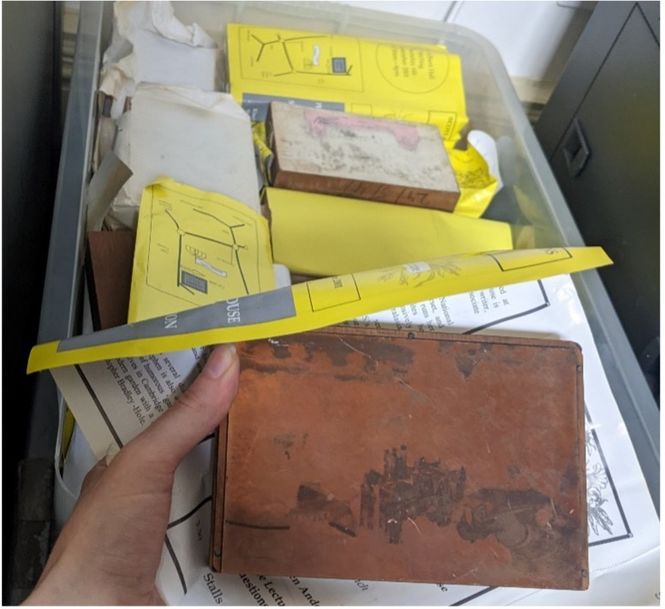
The art findings continued when cataloguing the diamond jubilee book; this contains submissions for the diamond jubilee of Scotland’s Garden Scheme Address/Telephone Book. These submissions include watercolours, poems, recipes, and creative writing – it was clear they received a large number of submissions as they are noted with a tick/yes or a cross/no. Due to the number of submissions these obviously needed whittling down.
If you have a copy of, or can provide any information about the Scotland’s Garden Scheme Diamond Jubilee Address/Telephone Book, we would love to hear from you!
I liked this drawing submitted by Joyce Laing of the view from Kellie Lodging Garden in Pittenweem, Fife.
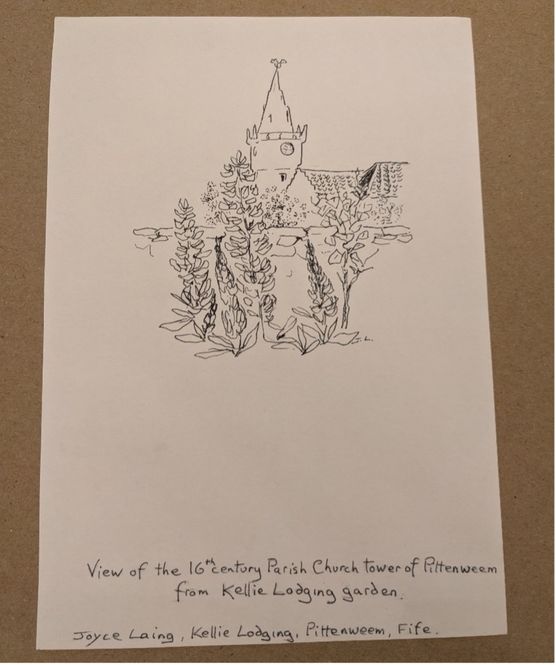
A bit of research showed that sadly Joyce passed away last year in 2022, but also highlighted that Joyce, like SGS, had strong links to health as well as enjoying gardens. Joyce was a pioneering art therapist, the first art therapist in Scotland no less, working with psychiatric patients in prisons. The archive means I’ve learned so many diverse stories.
One thing we’re not sure about is in a different type of record you may be able to help with. There are records which were organisations and individuals requesting a copy of the handbook – but the acronyms used for requested SGS publications are unclear. Obviously, ‘1 Handbook’ means that the organisation, business or individual has requested one handbook, but we are not sure what the acronyms ‘F.T.L’ and ‘M.C.T.L’ refer to. They may refer to something else ordered but get in touch if you can solve this small puzzle!
I hope that has given you an insight into the SGS archive. As current garden owners, volunteers, gardeners, recipient charities, and visitors are all so integral to Scotland’s Garden Scheme - you’re all creating the records which will fill up future archive boxes as we speak.
Alice
Thank you so much Alice, for all your hard work at head office and for documenting your experience.
If you are able to provide any of the missing documents noted above or any further information regarding the articles mentioned here, please get in touch at: info@scotlandsgardens.org
We would love to hear from you!


 Find a Garden
Find a Garden

 What's New
What's New

 Our Impact
Our Impact

 Join
Join


